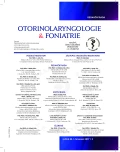Incidence of Complications in Operations on Thyroid Gland.
A Retrospective Analysis
Authors:
J. Lukáš 1,2; J. Astl 1; J. Paska 1; P. Jirák 1; J. Traboulsi 1; J. Štěpánek 1; Michal Černý 1
; J. Svárovský 1; J. Kačírková 1
Authors place of work:
Oddělení ORL a chirurgie hlavy a krku, Nemocnice Na Homolce, Praha
1; Otorinolaryngologická klinika, Lékařská fakulta UK v Plzni
2
Published in the journal:
Otorinolaryngol Foniatr, 66, 2017, No. 2, pp. 66-70.
Category:
Původní práce
Summary
Introduction:
Thyroidectomy belongs to most frequently performed operations in endocrinology surgery. The operations and potentially associated with the risk of complications, which may cause lifelong health consequences. The aim of the study was to analyze incidence of postoperative pareses of recurrent nerve and hypocalcemia.
Material and methods:
Retrospective analysis of patients operated on over the period of ten years included, in addition to sex, age, representation of benign diseases and malignant tumors, the number of performed operations, also the incidence of postoperative paresis of recurrent nerve (NLR) and hypocalcemia. For an objective comparison of the results of surgical therapy from the standpoint of incidence of NLP pareses the index of recurrent injury (IRI index) was determined. The surgeons were divided into four groups according to number of performed operations and the incidence of complications was analyzed there.
Results:
A total of 1334 patients at the average age of 52.5 years, 1113 of them were women (83.4%). Malignant tumors were diagnosed in 227 patients (17%), 222 of them were carcinomas (97.8%). Total thyroidectomy was performed in 1067 patients (80%) and hemithyroidectomy included 267 patients (20.0%). A unilateral paresis of recurrent nerve affected 1.4% of patients with malignant tumors and 0.7% of those with a benign disease (p=0.045). Permanent hypocalcemia affected 2% of patients with malignant tumors and 0.7% of those with a benign disease (p=0.011). The highest incidence of complications were encountered with medium advanced surgeons, permanent hypocalcemia affected 4.2% of the patients and unilateral paresis of recurrent nerve in 2.8% of the patients undergoing surgery.
Conclusion:
Results of the analysis confirm that postoperative complications are comparable with the large respected centers. The knowledge and experience of a thyroidal surgeon represent a higher guarantee of the intervention safety than the selection of a minimally radical surgery.
KEYWORDS:
total thyroidectomy, block cervical dissection, paresis of recurrent laryngeal nerve, hypocalcemia
Zdroje
1. Astl, J.: Chirurgická léčba nemocí štítné žlázy. 2. rozšířené vydání. Maxdorf, 2013.
2. Ciampi, R., Nikiforov,Y. E.: RET/PTC rearrangements and BRAF station in thyroid tumorigenesis. Endocrinology, 148, 2007,s. 936-941.
3. Čáp, J.: Uzel štítné žlázy. Klin. Farmakol. Farm., 25, 2011, 1, s. 28-32.
4. Dvořák, J., Dudešek B.: Štítná žláza, chirurgická anatomie operační technika. Třetí přepracované a rozšířené vydání. Nakladatelství SERIFA, Praha, 2015.
5. Dvořáková, M.: Endokrinní orbitopatie u dětí. Pediatr. praxi, 16, 2015, 1, s. 12-16.
6. Chan, W. F., Lang, B. H., Lo, C. Y.: The role of intraoperative neuromonitoring of recurrent laryngeal nerve during thyroidectomy: a comparative study on 1000 nerves at risk. Surgery, 140, 2006, 6, s. 866-872; discussion 872-873.
7. Jiskra, J.: Diagnostika a terapie tyreoidálních uzlů. Practicus, 4, 2011, s. 13-18.
8. Kastner, J., Zábrodský, M., Astl, J., Zvěřina, E., Mrzena, L., Šram, F. et al.: Chirurgická léčba jednostranné parézy zvratného nervu. Endoskopie, 19, 2001, 1, s. 21-27.
9. Krátký, J., Jiskra, J.: Nové možnosti diagnostiky tyreoidálních uzlů. DMEV, 16, 2013, 3, s.165-173.
10. Lukáš, J., Drábek, J., Dudešek, B., Važan, P., Stranská, J., Jančík, S. et al.: Correlation among the BRAFV600E gene mutation status, clinicopathological features of primary tumour, and lymph node metastasizing of papillary thyroid carcinoma. Exp. Clin. Endocrinol. Diabetes, 122, 2014, s. 268-272.
11. Ryška, A.: Co je nového v patologii štítné žlázy. Čes.-slov. Patol., 44, 2008, 4, s. 90-95.
12. Vlček, P.: Diferencovaný karcinom štítné žlázy-nový pohled na jeho léčbu. Onkologie, 5, 2011, 6, s. 329-332.
13. Zábrodský, M., Lukeš, P., BoučekA, J., Kastner, J., Kuchař, M., Chovanec, M., Betka, J.: Okamžitá revize u pacientů s oboustrannou obrnou zvratných nervů po operaci štítné žlázy a příštítných tělísek. Otorinolaryng. a Foniat./Prague/, 61, 2012, 2, s. 104-111.
Štítky
Audiologie a foniatrie Dětská otorinolaryngologie OtorinolaryngologieČlánek vyšel v časopise
Otorinolaryngologie a foniatrie

2017 Číslo 2
- Isoprinosin je bezpečný a účinný v léčbě pacientů s akutní respirační virovou infekcí
- Pacienti s infekcemi HPV a EBV a možnosti léčebné intervence pomocí inosin pranobexu
- Fexofenadin – nesedativní a imunomodulační antihistaminikum v léčbě alergických projevů
- Klinický obraz cytomegalové infekce
- Inosin pranobex v léčbě HPV infekcí děložního čípku
Nejčtenější v tomto čísle
- Hluboké krční záněty – diagnostika a terapie
- Profesní poškození sluchu hlukem – část 1.
-
Incidence komplikací u operací štítné žlázy
Retrospektivní analýza - CONE BEAM CT: použití mimo stomatologii
